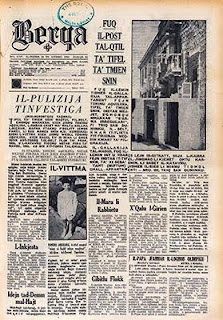1st NEWSPAPER
Newspapers published under the same name on a regular schedule first appeared in Venice, Italy, in the 16th century. Handwritten newspapers called avisi, or gazettes, appeared weekly as early as 1566.
They reported news brought to Venice by traders, such as accounts of wars and politics in other parts of Italy and Europe. Venetian gazettes established a style of journalism that most early printed newspapers followed—short sets of news items written under the name of the city they came from and the date on which they were sent. The oldest surviving copies of European newspapers are of two weeklies published in German in 1609—one in Strassburg (now Strasbourg, France) by Johann Carolus, the other in Wolfenbüttel, Germany, by Lucas Schulte.
They reported news brought to Venice by traders, such as accounts of wars and politics in other parts of Italy and Europe. Venetian gazettes established a style of journalism that most early printed newspapers followed—short sets of news items written under the name of the city they came from and the date on which they were sent. The oldest surviving copies of European newspapers are of two weeklies published in German in 1609—one in Strassburg (now Strasbourg, France) by Johann Carolus, the other in Wolfenbüttel, Germany, by Lucas Schulte.
Newspapers spread rapidly throughout Europe. One-page weeklies appeared in Basel, Switzerland, by 1610; in Frankfurt, Germany, and Vienna, Austria, by 1615; in Hamburg, Germany, by 1616; in Berlin, Germany, by 1617; and in Amsterdam, Netherlands, by 1618. The first newspaper printed in England appeared in 1621, and France produced a newspaper in 1631. However, printers in Amsterdam, a center of trade and of political and religious tolerance in the early 17th century, exported weeklies in French and in English as early as 1620. The first continuously published English newspaper was the Weekly News, published from 1622 to 1641. Italy's first printed weekly appeared by 1639, and Spain had one by 1641.
Early English newspapers were generally printed in one of two formats: in the style of the Dutch papers or in the style of the early German weeklies. Dutch-style papers compressed news stories onto four or fewer pages, while news in German-style weeklies covered up to 24 pages. English publishers first used the Dutch style but switched to the German style by 1622.
English newspapers were among the first in the world to use headlines to attract readers and woodcuts to illustrate stories. English newspapers also set new business standards. They hired women as reporters, printed advertisements as a source of revenue, and paid newsboys, or more commonly, newsgirls, to sell papers in the streets.
The fledgling English press faced censorship throughout much of the 17th century. Early newspapers called diurnals—the predecessors of today’s dailies—featured news from all over Europe and occasionally America or Asia. However, government officials discouraged reporting on local matters. In addition, the government tightly regulated print shops. In England, as in most other European countries, the government required printers to have licenses to print the news. Printers could lose their licenses if they published anything offensive to authorities.
The first major change in this arrangement came in the years before the outbreak of the English Civil War (1642-1648). As Parliament, under the leadership of Oliver Cromwell, struggled with King Charles I, national news assumed a new importance. Newspapers, liberated by the breakdown in the king's authority, began to feel free enough to discuss domestic politics. The first English newspaper to attempt to report on national news was the Heads of Several Proceedings in This Present Parliament, a weekly that appeared in 1641. The public’s appetite for domestic news grew steadily, and soon a number of papers covered national politics and other previously censored topics. In 1644 writer John Milton articulated the ideal of freedom of the press with great eloquence in his essayAreopagitica. However, when Oliver Cromwell consolidated his power after Charles I was beheaded in 1649, he cracked down on the press. He allowed only a few authorized newspapers to be printed.
After the monarchy was restored under King Charles II in 1660, the government gradually ended licensing provisions and other restrictions. The English press published in an atmosphere of considerable freedom—as long as it did not criticize the government. During the upheaval of the Glorious Revolution in 1688 (when Parliament deposed King James II in favor of William of Orange), the English press burst free of nearly all government restrictions. The law that required printers to obtain licenses lapsed in 1695. Belief in the right of the press to question and criticize government eventually took hold in England and migrated to its American colonies.




Comments
Post a Comment